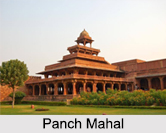 Panch Mahal is a five storey palace located inside Fatehpur Sikri, Uttar Pradesh. This palace was built by the Mughal Emperor Akbar for relaxation and entertainment purpose. Panch Mahal is located on the north-east direction of Jodha Bai"s Palace. The architecture of Panch Mahal was inspired by that of a Buddhist temple. This extra ordinary building was called badgir or wind tower, which was constructed to alleviate the intense summer heat and is a very popular architectural mechanism of Persian architecture.
Panch Mahal is a five storey palace located inside Fatehpur Sikri, Uttar Pradesh. This palace was built by the Mughal Emperor Akbar for relaxation and entertainment purpose. Panch Mahal is located on the north-east direction of Jodha Bai"s Palace. The architecture of Panch Mahal was inspired by that of a Buddhist temple. This extra ordinary building was called badgir or wind tower, which was constructed to alleviate the intense summer heat and is a very popular architectural mechanism of Persian architecture.
Architecture of Panch Mahal
Panch Mahal is an extraordinary structure, entirely columnar, consisting of 4 storeys of decreasing size, disposed asymmetrically upon a ground floor that contains 84 columns, a number regarded as highly auspicious by Hindus. The first storey contains 56 columns; the second, 20; the third, 12; and the top storey is a single, domed kiosk supported on 4 pillars, taking the total to 176. Earlier the pillars used to have net screens in between them which acted as purdah for the royal ladies. The topmost part of the palace is made in a traditional chhatri style dome which enhances its beauty.
Pillars of Panch Mahal are decorated with beautiful carvings of floral vases and rosettes. Some are circular with tiny blossoms carved on them; others octagonal with Fleur-de-Louis patterns; some have weaves around their centres; and one carries a beautiful version of the bell-and-chain motif. There is also a pool in front of the Panch Mahal, called the "Anoop Talab", which was filled with water and acted as a venue for musical performances during Akbar"s time.
This article is a stub. You can enrich by adding more information to it. Send your Write Up to content@indianetzone.com



















